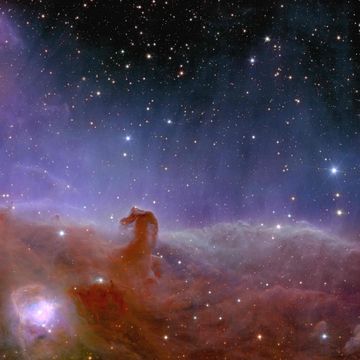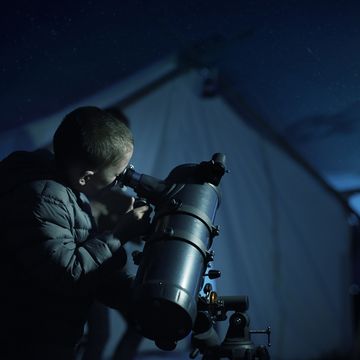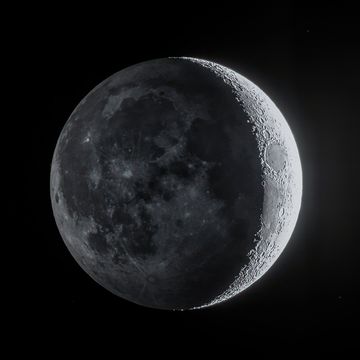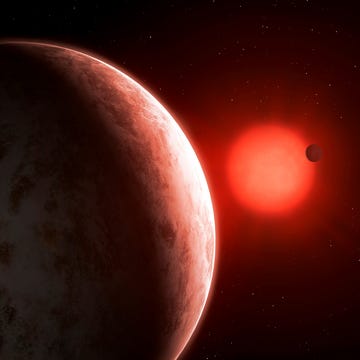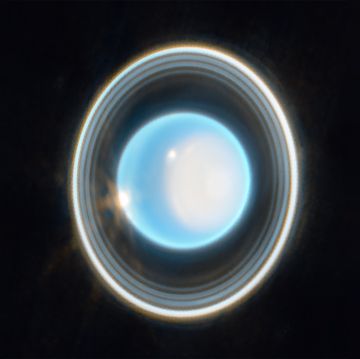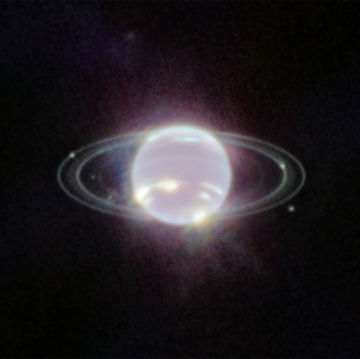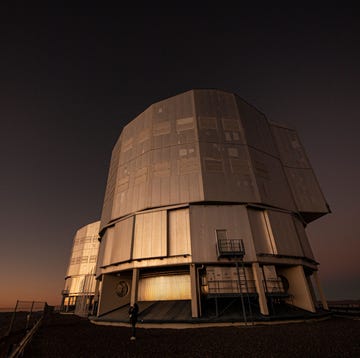Comet Siding Spring hails from the Oort Cloud, a spherical cloud of icy, dusty objects at the very edge of the Solar System. But this fall, it will pay a visit to our neighborhood.
In October, Siding Spring will pass within just 82,000 miles of Mars; that's a third of the distance between Earth and the Moon. Its coma of gas will fully engulf the planet for several hours during the flyby on October 19. Earth-bound astronomers, who've been studying the comet using the Hubble Space Telescope (HST) and the Swift Observatory, can't wait.
"Seen from Mars, the comet would be absolutely spectacular," University of Maryland astronomer Dennis Bodewits tells Popular Mechanics. "It may be as bright as Venus as seen from Earth, and it will move very quickly across the sky, at more than twice the rate of the Space Station as seen from Earth." Some scientists had speculated that debris from Siding Spring's tail might cause a meteor shower on Mars, but that now appears unlikely.
Satellites orbiting Mars may find themselves "pressed into service as a provisional comet observation fleet," NASA said in a statement. The Mars Reconnaissance Orbiter's HiRISE camera, which has taken remarkably detailed photos of Martian landforms, could also take images of Siding Spring as it passes by. NASA expects the nucleus to show up at a resolution of 460 feet per pixel.
NASA's Mars Atmosphere and Volatile Evolution (MAVEN) and India's Space Research Organization's Mars Orbiter Mission (MOM) will both arrive in Mars orbit in late September, just in time for the close encounter with Siding Spring. MAVEN's mission focuses on chemicals in Mars' upper atmosphere, so it will be in a perfect position to study Siding Spring's coma as it brushes against the Martian atmosphere. MOM will bring a new camera and a mass spectrometer.
Satellite Danger?
Satellites are built to withstand "background" impacts, minor collisions with the space dust that normally drifts around the Solar System. Siding Spring, however, will bring much more dust than usual, and particles will be travelling three times faster than the usual space dust. The risk to the satellites depends on how much dust the comet releases. At the beginning of 2014, large particles began coming off Siding Spring, which worried observers. But experts say the satellites should survive.
"We used HST and Swift to observe the comet then (we've been on it for a while now) and determined that even that dust posed no threat," Bodewits says. However, he added that comets are unpredictable and the situation could change. If it does, the orbiters could seek shelter on the far side of Mars, or they could rotate to shield their most vulnerable components from the dust.
Swift will track Siding Spring as it passes Mars and reaches perihelion—its closest approach to the Sun— six days later and then heads outward again. After that, scientists will bid Siding Spring farewell forever. "Siding Spring has a hyperbolic orbit and will be slung out of the Solar System," Bodewits says.
"Dynamically New"
Some comets that get knocked out of the Oort cloud make regular trips through the inner Solar System. Siding Spring, however, is what scientists call a "Dynamically New" comet. It has been in cold storage since the Solar System formed; this will be its first thaw.
"Dynamically New comets have never been heated by the Sun and retain some of the most primordial material available for observation in the Solar System," Bodewits says.
Every time a comet approaches the Sun, the heat changes the comet chemically and physically. Siding Spring offers a rare opportunity to see what comets look like before those changes, and it may also provide a glimpse at the earliest chemical makeup of our Solar System.
"This may very well be the only time we ever get to see the nucleus of a dynamically new comet," Bodewits told Popular Mechanics.
Heating up an icy comet can be a violent process. In March, as Siding Spring drew nearer to us, the Hubble Space Telescope watched two powerful jets of water burst out of the comet in roughly opposite directions. Researchers later calculated that as the Sun heats the comet, it releases enough water to fill almost two Olympic swimming pools a day.
You'll be able to see it, too. If you have binoculars or a telescope, Siding Spring will be visible from most of the Southern Hemisphere throughout September.



